With the Federal Reserve expected to make its first interest rate cut in four years Wednesday, it’s time to take a look at how stocks performed at the start of prior easing cycles. Expectations are running high for the market’s already strong performance this year to continue after the Fed slashes rates. The S & P 500 touched a record high on Tuesday , bringing its year-to-date gain to more than 18%. But how it will perform from here depends largely on the economy, historical data shows. In total, across all cycles, the S & P 500’s performance in the aftermath of the first cut was largely positive but with some big misses when the economy turned down. Overall, the broader index was higher 70% of the time three- and six months out, and 80% of the time one year later, according to Canaccord Genuity, which reviewed the last 10 easing cycles going back to 1970. The S & P 500 averaged a 5.5% gain in the first three months after an initial cut, 10.6% six months later, and 11.3% one year out. But exclude the times when a recession followed and compute only using the soft-landing scenarios — which is the consensus this time — and the performance gets even better. (A recessionary scenario was defined by Canaccord as one in which the economy was already in a downturn or entered one within 12 months of the first cut). In the years when the S & P 500 experienced no recession during or soon after the first reduction — such as in 1984, 1989, 1995 and 1998 — the benchmark was higher 100% of the time three, six and 12 months later. On average, the broader index jumped 10.2% three months later, 14.7% six months out, and 18.6% one year afterward. .SPX YTD mountain S & P 500, ytd Other investment banks have noted this discrepancy, with Bank of America Securities also highlighting the pattern in a recent note. “An easing cycle itself isn’t necessarily positive. In fact, [the S & P 500] posted weaker returns after first rate cuts on average, but with distinct divergence based on the economy,” the firm’s Ohsung Kwon wrote on Monday. The S & P 500 “rose only 20% of the time in 100 trading days after first cuts when there was a recession within six months, but 100% of the time when there was no recession (+8% on avg.),” she said. By sector, Canaccord Genuity noted the three sectors averaging the best returns one year later were communication services, information technology and health care. The worst-performing sectors 12 months after a rate cut were materials, utilities and consumer discretionary.

























































